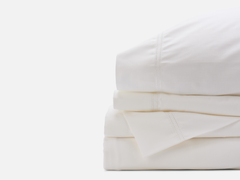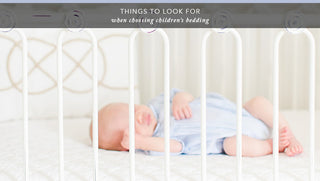Some of our favorite childhood memories have to do with our beds—blanket forts with our siblings, snuggling under the covers while our parents read us a story, or just jumping for joy on the mattress. We’re not children anymore, but we can help ours make the same great memories—and those memories start with your kid’s bedding.
From character-decorated sheets to grandma’s old quilt blanket, there are a lot of choices to sort through. Knowing what things to look for when choosing children’s bedding will help you craft the perfect bed for your kids.
Safety
Safety is first, especially where our children are concerned. So, the same is true when you’re choosing bedding for them. This is mostly a concern when you have babies. Less is more when it comes to baby bedding. Use tightly-fitted, breathable bed sheets that cover the mattress.
Blankets in the crib can create a suffocation hazard for your babies if they’re younger than a year. So if you received any crocheted blankets at your baby’s shower or have any heirloom blankets you want to pass on, wait until your baby is out of the crib.
Size
Once you know it’s safe to give your baby bedding other than a fitted sheet, you can start finding the bedding to fit your child’s bed.
Your options are more limited if you’re working with a toddler bed instead of a full-sized bed. Because of this—and because it sometimes helps children to have fewer transitions—many parents opt to transition their kids from a crib straight to a twin bed instead of a toddler bed. That depends on your family’s preferences and the space available.
Durability
Even the most conscientious child isn’t always gentle on their belongings. Childhood is a time of exuberance, spills, and tears, so you want to make your child’s bedding is up to the challenge. Several factors go into bedding’s durability.
Quality
The old expression “You get what you paid for” applies to a lot of things—and that includes bedding. If you buy cheap, low-quality bed sheets, they won’t last for a very long time. Quality is the first step when it comes to finding durable, long-lasting sheets that’ll withstand being transformed into blanket forts, tablecloths for living room picnics, and even your child tossing and turning at night.
Material
If you’ve ever read your kids the story of the Three Little Pigs, then you know that what something is made of determines just how durable it is. The same is true with your bedding. Even though polyester bedding can seem more durable from the outside, natural bedding is known to last a good deal longer than its synthetic counterparts.
Weave
How something is made is just as important as what it’s made from. A bedding’s weave indicates quality and durability. Tighter weaves are less likely to pill. This means they won’t develop those tiny, shabby, rough little fiber balls that are uncomfortable for children to lie on (especially if they have sensitive skin.)
There are four main types of weave: flannel, sateen, twill, and percale. All of them have their own benefits and pitfalls for kid’s bedding, but as far as durability foes, percale is the tightest and least likely to pill.
Washable
Our kids’ bedding gets dirty in plenty of ways—from midnight bed wetting, to spilled juice boxes, to furry friends who decide to cozy up to our kids at night. And the more dirt the bedding accumulates, the more likely it is for sheets to irritate the skin and exacerbate allergies.
Naturally, we all want sheets durable enough to withstand the ravages of the washing machine. Durability is the name of the game. To get the most washable sheets, look for all-natural material with long fibers such as long-fiber cotton.
Comfort
Getting children into bed isn’t always easy. It’s amazing how many excuses kids can come up with to stay up just a little longer, from a suddenly full bladder to a toy that “mysteriously went missing.”
You don’t want your child’s bedsheets to be one of the things that keep them from staying in bed at night. Here are some things to look for when choosing children’s bedding that’s comfortable.
Texture
If kids have sensitive skin, they’ll chafe and squirm any time they must wear itchy formal clothing. You wouldn’t want their sleeping experience to be equally uncomfortable. So, when it comes to the comfort of your child’s bedding, it’s important to get the texture just right.
The best texture for your child’s bed sheets will largely depend on your child. If you aren’t sure how your child will react to a certain type of bedding, have them test out the fabric by rubbing it against their face. If they find it rough and uncomfortable in that scenario, they won’t want to sleep on it.
Warmth
The last thing any of us want is for our kids to be awake and shivering in the middle of the night. Heavy, well-made sheets will help keep them warm when they sleep. Furthermore, you can use a duvet to keep the blanket clean.
But just because quilts tend to be lighter than duvets doesn’t mean your child is doomed to a cold night if they have them. Layering your child’s bed with some of our American-made blankets and throws will ensure your child is cozy all night.
Breathability
Sometimes, your child can be kept awake at night because they’re too warm. The best way to balance temperature is to make sure your child’s bedding is breathable.
That starts with choosing quality bedding made with a breathable material. All-natural materials like cotton are much more breathable than polyester or polyester-cotton blends.
Aesthetic
Oftentimes, our first thought when choosing kids’ bedding is to pick any that have smiling cartoon characters on them. However, kids are notorious for growing out of characters and shows as soon as a new one premieres. That means you may be buying a whole new set of sheets.
Sometimes your best bet is to choose neutral sheets that will grow with your child and will match the rest of the room—whatever theme it is.
Childhood is a time to make memories, and at Red Land Cotton, our goal is to create the quality sheets to make your kid’s bed a dream come true.



